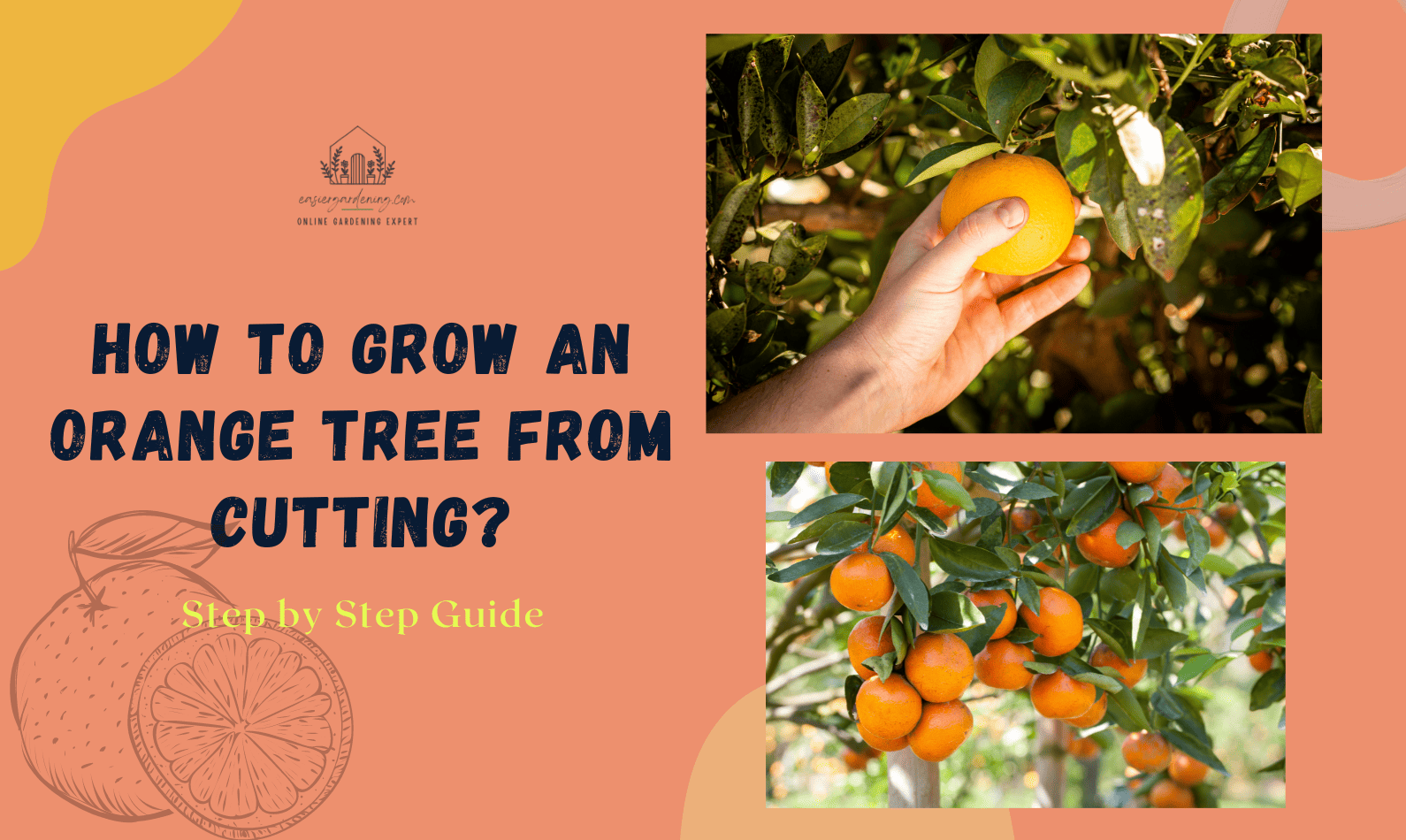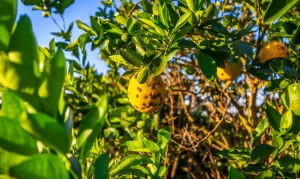How to Grow an Orange Tree from Cutting?: Orange trees (Citrus sinensis), with their fragrant blossoms and showy, edible berries, add ornamental and practical value to landscape plantings in USDA plant hardiness zones 9 to 11. Cuttings are the easiest way to propagate orange trees at home since they root consistently and faithfully replicate the parent plant’s favorable fruiting characteristics. Orange cuttings, on the other hand, root slowly and must be handled with a strong hormone and held in humid, moist conditions to hasten to root.
Contents
- Steps How to Grow an Orange Tree from Cutting
- Step 1
- Step 2
- Step 3
- Step 4
- Step 5
- Step 6
- Step 7
- Step 8
- Step 9
- Step 10
- Step 11
- How and Where to Plant a Citrus Tree?
- How to Take Care of a Citrus Tree?
- What are the Common Pests and Diseases?
- How to Harvest and Store Citrus?
- Conclusion: How to Grow an Orange Tree from Cutting?
Steps How to Grow an Orange Tree from Cutting
Step 1
Take cuttings of orange trees in late spring or early summer after the current season’s growth has hardened and the blossoms have faded. Do not take cuttings from branches that have a lot of active blossoms or berries.
Step 2
Before gathering the orange cuttings, prepare a rooting container. Fill 6-inch pots halfway with perlite and halfway with coarse quartz sand. Create a pot for each orange tree that you want to propagate.
Step 3
Cut 6- to 10-inch pieces from the tip of a healthy orange branch. Choose those with a leafy tip and a diameter of less than 1/4 inch. Using sharp, freshly cleaned bypass shears, sever the cutting 1/8 inch below a collection of leaves.
Step 4
Remove all of the leaves from the orange cutting’s stem’s bottom half. Remove half of the leaves from the tip, as well as any fading or freshly shaped blossoms and berries. Remove a 1/8-inch-wide sliver of bark from the stem’s base.
Step 5
Apply 0.1 percent IBA (indolebutyric acid) rooting hormone talc to the severed end of the orange cutting. Use a clean paintbrush or a new cotton swab to apply the talc. Tap the stem to get rid of any caked-on powder.
Step 6
Make a planting hole deep enough to fit the bottom half of the orange cutting in the perlite-and-sand mixture. Insert the hormone-treated end of the cutting into the hole and press tightly against the stem with the perlite mixture.
Step 7
Place the potted orange cutting within a lightly shaded cold frame or near a wide window with indirect sunlight. A propagation mat set to 75 degrees Fahrenheit should be used to warm the pot. Do not turn down the heat at night.
Step 8
While the orange cutting roots, keep the perlite mixture moist at all times. To avoid rot and fungal infections, allow the top inch of soil to dry out between watering. To keep the leaves hydrated, mist the foliage with a spray bottle any time you drink.
Step 9
Three months after potting the orange cutting, check for roots. Gently pull on the stem’s base to see if it is attached to the perlite mixture by roots. After the cutting roots have been removed, remove the propagation pad.
Step 10
For the first summer, grow the rooted orange cutting outside in a sheltered, lightly shaded location. Allow it to gradually acclimate to direct sunlight in early autumn once daytime temperatures have cooled slightly.
Step 11
When the weather is cool and moist, plant the orange tree in a prepared bed or wide container in mid-to-late autumn—plant in full sun and daily irrigation in neutral or slightly acidic soil.
Read more about How to Grow Lemon Tree from a Cutting?
Common Questions about Growing Lemons and Oranges
Since most citrus varieties are self-fertile, only one tree is needed to produce fruit. Fruit-bearing begins when the trees are between 3 and 6 years old on average; however, exact timing can vary depending on the type of citrus (lemons, oranges, grapefruit, etc.), cultivar, climate, plant health and care, and other factors. Flowering is not seasonal but happens during periods of warm weather and consistent rainfall. Flowers and fruits can appear at the same time.
How and Where to Plant a Citrus Tree?
- Citrus trees should be planted in a sunny, wind-free location.
- Trees can be planted at any time in the citrus belt (a loosely defined region extending from southern California to Florida), but spring is the best time for container-grown plants.
- Citrus trees should be planted 12 to 25 feet apart, while dwarf citrus trees should be planted 6 to 10 feet apart. The precise distance varies according to the variety—the greater the size of the fruit, the greater the reach.
- Place the trees on a small mound if the soil is not well-drained to avoid waterlogging.
- To start citrus trees from seeds within, first, extract the seeds from the desired fruit. Soak the seeds in water overnight before planting them 12 inches deep in damp potting soil. Cover the pot with a plastic bag or wrap and place it in a warm, sunny location for a few weeks or until the seeds sprout. Remove the plastic, but keep the pot near a warm, sunny window.
How to Take Care of a Citrus Tree?
- Feed the tree a balanced fertilizer (such as 6-6-6) a few weeks after planting and for the first few years (before bearing age). Find out more about soil amendments and how to prepare the soil for planting.
- Provide nutrients to newly bearing trees not only to continue branch and leaf development but also to replace nutrients lost during fruit formation. A citrus mix would be perfect.
- Check the manufacturer’s instructions, ask a garden nursery, or consult your local cooperative extension on how much fertilizer to add during each year of a tree’s growth.
- Mulches are not recommended for citrus trees; however, if trees are planted in a cultivated plant bed with mulch, leave at least 12 inches of bare ground between the tree trunk and the mulch. To prevent weed seeds from germinating, pre-emergent herbicides may be used.
- Citrus trees do not require fruit thinning because they are prone to what is known as the “June drop.” Citrus trees naturally lose a number of their immature fruit in late spring or early summer (May or June for the majority of the country).
What are the Common Pests and Diseases?
- Aphids
- Spider Mites
- Root and Crown Rots
- Fungal Leaf Spots
- Fruit Flies
- Tristeza Virus spread by Aphids
Read more about How To Grow Cucumbers?
How to Harvest and Store Citrus?
- Citrus fruits can take 6 to 8 months to ripen, depending on the environment.
- Citrus fruits do not ripen on the tree, so don’t select them too early.
- Taste is the most accurate measure of ripeness.
- Break the fruit off with pruning shears, or pull the fruit stalk from the tree to harvest it.
- Citrus fruits that are not harmed can be kept at cool temperatures for several weeks.
Conclusion: How to Grow an Orange Tree from Cutting?
Learning how to grow an orange tree is a worthwhile project for the home gardener, particularly once your orange trees begin to produce fruit. The treatment of an orange tree is not difficult. When caring for an orange tree, a few simple steps will keep your tree safe and probably increase fruit production.



